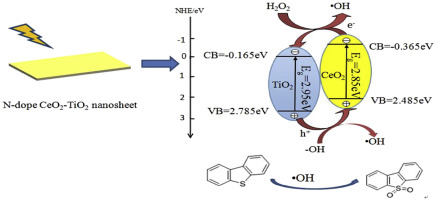当前位置:
X-MOL 学术
›
J. Alloys Compd.
›
论文详情
Our official English website, www.x-mol.net, welcomes your
feedback! (Note: you will need to create a separate account there.)
Biotemplating synthesis of N-doped two-dimensional CeO2–TiO2 nanosheets with enhanced visible light photocatalytic desulfurization performance
Journal of Alloys and Compounds ( IF 5.8 ) Pub Date : 2020-01-01 , DOI: 10.1016/j.jallcom.2019.152326 Xiaowang Lu , Xiazhang Li , Feng Chen , Zhigang Chen , Junchao Qian , Qinfang Zhang
Journal of Alloys and Compounds ( IF 5.8 ) Pub Date : 2020-01-01 , DOI: 10.1016/j.jallcom.2019.152326 Xiaowang Lu , Xiazhang Li , Feng Chen , Zhigang Chen , Junchao Qian , Qinfang Zhang

|
Abstract The novel nitrogen doped two-dimensional CeO2–TiO2 nanosheets with a thickness of less than 5 nm were synthesized by a facile impregnation method using Chinese rose petals as biological templates. The detailed characterization by field emission scanning electron microscope (FESEM), transmission electron microscope (TEM), atomic force microscopy (AFM) and X-ray photoelectron spectroscopy (XPS) exhibited that the CeO2–TiO2 composites exactly duplicated the microstructure of Chinese rose petal and the self-owned nitrogen was successfully doped into the CeO2–TiO2 composites, which could enhance the visible light absorption efficiency. UV–Vis diffuse reflection spectroscopy (DRS), photocurrent measurement (PM), electrochemical impedance spectroscopy(EIS) and photoluminescence spectroscopy (PL) were used to analyze the electrons and holes separation efficiency, which revealed that CeO2 and TiO2 formed well-defined hetero junctions promoting the effective separation of photogenerated electrons and holes. The photocatalytic activity of the samples was evaluated by photocatalytic degradation of dibenzothiophene (DBT) in model oil. The amount of hydrogenperoxide (H2O2) and photocatalysts, the molar ratios of Ce and Ti in CeO2–TiO2 composites as photocatalytic reaction conditions were investigated. Results showed that the removal rate of DBT could reach 93.7% under visible light irritation for 3 h, when the molar ratio of Ce/Ti was 1/1, the mass ratio of photocatalyst/DBT was 1/2 and the molar ratio of H2O2/DBT was 2/1. The trapping experiments confirmed that the photoinduced active species (•OH radical) was responsible for the degradation of DBT. Further studies demonstrated that DBT was converted to the corresponding sulfone, which could be extracted by the polar solvent. Moreover, a plausible mechanism for the photocatalytic oxidative desulfurization of this nanocomposite was proposed.
中文翻译:

具有增强的可见光光催化脱硫性能的 N 掺杂二维 CeO2-TiO2 纳米片的生物模板合成
摘要 以月季花瓣为生物模板,通过简便的浸渍法合成了厚度小于5 nm的新型氮掺杂二维CeO2-TiO2纳米片。通过场发射扫描电子显微镜 (FESEM)、透射电子显微镜 (TEM)、原子力显微镜 (AFM) 和 X 射线光电子能谱 (XPS) 的详细表征表明,CeO2-TiO2 复合材料完全复制了玫瑰花瓣的微观结构并且自有氮成功地掺杂到CeO2-TiO2复合材料中,可以提高可见光吸收效率。紫外-可见漫反射光谱 (DRS)、光电流测量 (PM)、电化学阻抗谱(EIS)和光致发光光谱(PL)分析电子和空穴的分离效率,结果表明CeO2和TiO2形成了明确的异质结,促进了光生电子和空穴的有效分离。通过光催化降解模型油中的二苯并噻吩(DBT)来评估样品的光催化活性。研究了作为光催化反应条件的过氧化氢 (H2O2) 和光催化剂的量、CeO2-TiO2 复合材料中 Ce 和 Ti 的摩尔比。结果表明,当Ce/Ti摩尔比为1/1、光催化剂/DBT质量比为1/2、H2O2摩尔比时,可见光刺激3h对DBT的去除率可达93.7%。 /DBT 是 2/1。捕获实验证实,光致活性物质(•OH 自由基)是 DBT 降解的原因。进一步的研究表明,DBT 转化为相应的砜,可以用极性溶剂萃取。此外,还提出了该纳米复合材料光催化氧化脱硫的合理机制。
更新日期:2020-01-01
中文翻译:

具有增强的可见光光催化脱硫性能的 N 掺杂二维 CeO2-TiO2 纳米片的生物模板合成
摘要 以月季花瓣为生物模板,通过简便的浸渍法合成了厚度小于5 nm的新型氮掺杂二维CeO2-TiO2纳米片。通过场发射扫描电子显微镜 (FESEM)、透射电子显微镜 (TEM)、原子力显微镜 (AFM) 和 X 射线光电子能谱 (XPS) 的详细表征表明,CeO2-TiO2 复合材料完全复制了玫瑰花瓣的微观结构并且自有氮成功地掺杂到CeO2-TiO2复合材料中,可以提高可见光吸收效率。紫外-可见漫反射光谱 (DRS)、光电流测量 (PM)、电化学阻抗谱(EIS)和光致发光光谱(PL)分析电子和空穴的分离效率,结果表明CeO2和TiO2形成了明确的异质结,促进了光生电子和空穴的有效分离。通过光催化降解模型油中的二苯并噻吩(DBT)来评估样品的光催化活性。研究了作为光催化反应条件的过氧化氢 (H2O2) 和光催化剂的量、CeO2-TiO2 复合材料中 Ce 和 Ti 的摩尔比。结果表明,当Ce/Ti摩尔比为1/1、光催化剂/DBT质量比为1/2、H2O2摩尔比时,可见光刺激3h对DBT的去除率可达93.7%。 /DBT 是 2/1。捕获实验证实,光致活性物质(•OH 自由基)是 DBT 降解的原因。进一步的研究表明,DBT 转化为相应的砜,可以用极性溶剂萃取。此外,还提出了该纳米复合材料光催化氧化脱硫的合理机制。













































 京公网安备 11010802027423号
京公网安备 11010802027423号